Biogenic Elements of Atmospheric Fallout and Impact of Sub-Mediterranean Forest Communities of Downy Oaks on Changes in the Chemical Composition of Atmospheric Precipitation
Abstract
:1. Introduction
2. Materials and Methods
3. Results
3.1. Acidity
3.2. Inorganic Nitrogen
3.3. Inorganic Phosphorus
3.4. Dependence of the Biogenic Elements Content on Weather Conditions
4. Discussion
4.1. Acidity
4.2. Inorganic Nitrogen
4.3. Inorganic Phosphorus
4.4. Dependence of the Biogenic Elements Content on Weather Conditions
5. Conclusions
Author Contributions
Funding
Data Availability Statement
Acknowledgments
Conflicts of Interest
References
- Pierret, M.-C.; Viville, D.; Dambrine, E.; Cotel, S.; Probst, A. Twenty-five year record of chemicals in open field precipitation and throughfall from a medium-altitude forest catchment (Strengbach—NE France): An obvious response to atmospheric pollution trends. Atmos. Environ. 2019, 202, 296–314. [Google Scholar] [CrossRef]
- Shiltsova, G.V.; Lastochkina, V.G. Influence of the canopy of pine and birch forests on the chemical composition of precipitation in the Kivach Nature Reserve. Proc. Karal Sci. Cent. Russ. Acad. Sci. 2006, 10, 180–184. [Google Scholar]
- The 16th Baltic Sea Parliamentary Conference, Berlin, Germany, 27–28 August 2007. Available online: http://www.bspc.net/page/show/26 (accessed on 2 August 2022).
- De Schrijver, A.; Geudens, G.; Augusto, L.; Staelens, J.; Mertens, J.; Wuyts, K.; Gielis, L.; Verheyen, K. The effect of forest type on throughfall deposition and seepage flux: A review. Oecologia 2007, 153, 663–674. [Google Scholar] [CrossRef] [PubMed]
- Zhang, G.; Zeng, G.-M.; Du, C.-Y.; Jiang, Y.-M.; Su, X.-K.; Xiang, R.-J.; Huang, L.; Xu, M.; Zhang, C. Deposition patterns in bulk precipitation and throughfall in a subtropical mixed forest in central-south China. For. Int. J. For. Res. 2007, 80, 211–221. [Google Scholar] [CrossRef]
- Pristova, T.A. Chemical composition of atmospheric precipitation, undercrown and surface waters in the middle taiga deciduous plantations of post-cutting origin. Theor. Appl. Ecol. 2022, 2, 63–69. [Google Scholar] [CrossRef]
- Gandois, L.; Tipping, E.; Dumat, C.; Probst, A. Canopy influence on trace metal atmospheric inputs on forest ecosystems: Speciation in throughfall. Atmos. Environ. 2010, 44, 824–833. [Google Scholar] [CrossRef]
- Yang, B.; Lee, D.K.; Heo, H.K.; Biging, G. The effects of tree characteristics on rainfall interception in urban areas. Landsc. Ecol. Eng. 2019, 15, 289–296. [Google Scholar] [CrossRef]
- Dubenok, N.N.; Lebedev, A.V.; Gemonov, A.V. Hydrological Role of Forest Stands in a Small Catchment Basin. Russ. Agric. Sci. 2021, 47, 323–327. [Google Scholar] [CrossRef]
- Chen, L.C.; Wang, L.J.; Martin, C.E.; Lin, T.C. Mediation of stemflow water and nutrient availabilities by epiphytes growing above other epiphytes in a subtropical forest. Ecohydrology 2019, 12, e2140. [Google Scholar] [CrossRef]
- Hargis, H.; Gotsch, S.G.; Porada, P.; Moore, G.W.; Ferguson, B.; Van Stan, J.T., II. Arboreal Epiphytes in the Soil-Atmosphere Interface: How Often Are the Biggest “Buckets” in the Canopy Empty? Geosciences 2019, 9, 342. [Google Scholar] [CrossRef]
- Knops, J.M.H.; Iii, T.N.; Boucher, V.L.; Schlesinger, W.H. Mineral cycling and epiphytic lichens: Implications at the ecosystem level. Lichenology 1991, 23, 309–321. [Google Scholar] [CrossRef]
- Townsend, A.R.; Asner, G.P.; Cleveland, C.C. The biogeochemical heterogeneity of tropical forests. Trends Ecol. Evol. 2008, 23, 424–431. [Google Scholar] [CrossRef]
- McDowell, W.H.; Pérez-Rivera, K.X.; Shaw, M.E. Assessing the ecological significance of throughfall in forest ecosystems. In Forest-Water Interactions; Springer: Cham, Switzerland, 2020; pp. 299–318. [Google Scholar]
- Asner, G.P.; Martin, R.E.; Knapp, D.E.; Tupayachi, R.; Anderson, C.; Carranza, L.; Weiss, P. Spectroscopy of canopy chemicals in humid tropical forests. Remote Sens. Environ. 2011, 115, 3587–3598. [Google Scholar] [CrossRef]
- Tao, J.; Zuo, J.; He, Z.; Wang, Y.; Liu, J.; Liu, W.; Cornelissen, J.H. Traits including leaf dry matter content and leaf pH dominate over forest soil pH as drivers of litter decomposition among 60 species. Funct. Ecol. 2019, 33, 1798–1810. [Google Scholar] [CrossRef]
- Rahman, M.M.; Tsukamoto, J. Leaf traits, litter decomposability and forest floor dynamics in an evergreen-and a deciduous-broadleaved forest in warm temperate Japan. Forestry 2013, 86, 441–451. [Google Scholar] [CrossRef]
- Jochheim, H.; Lüttschwager, D.; Riek, W. Stem distance as an explanatory variable for the spatial distribution and chemical conditions of stand precipitation and soil solution under beech (Fagus sylvatica L.) trees. J. Hydrol. 2022, 608, 127629. [Google Scholar] [CrossRef]
- Kozhevnikova, N.K.; Lutsenko, T.N.; Boldeskul, A.G.; Lupakov, S.Y.; Shamov, V.V. Water migration of macroelements in coniferous-broad-leaved forests of Sikhote-Alin. Sib. For. J. 2017, 3, 60–73. [Google Scholar]
- Kravchenko, I.Y. Influence of the coniferous forest canopy on the chemical composition of atmospheric precipitation. In Geography: The Development of Science and Education; Solomin, V.P., Rumyantsev, V.A., Subetto, D.A., Lovelius, N.V., Eds.; Herzen University: Saint Petersburg, Russia, 2018; pp. 108–112. [Google Scholar]
- Martynyuk, A.A.; Doronicheva, E.V.; Rykova, T.V. Changes in the chemical composition of natural sediments under the canopy of pine plantations under conditions of technogenic pollution of the environment. Lisoviy Zhurnal 2011, 1, 8–11. [Google Scholar]
- Jiang, Z.-Y.; Zhi, Q.-Y.; Van Stan, J.T.; Zhang, S.-Y.; Xiao, Y.-H.; Chen, X.-Y.; Yang, X.; Zhou, H.-Y.; Hu, Z.-M.; Wu, H.-W. Rainfall partitioning and associated chemical alteration in three subtropical urban tree species. J. Hydrol. 2021, 603, 127109. [Google Scholar] [CrossRef]
- Roulier, M.; Bueno, M.; Coppin, F.; Nicolas, M.; Thiry, Y.; Rigal, F.; Pannier, F.; Le Hécho, I. Atmospheric iodine, selenium and caesium depositions in France: II. Influence of forest canopies. Chemosphere 2021, 273, 128952. [Google Scholar] [CrossRef]
- Van Stan II, J.T.; Pypker, T.G. A review and evaluation of forest canopy epiphyte roles in the partitioning and chemical alteration of precipitation. Sci. Total Environ. 2015, 536, 813–824. [Google Scholar] [CrossRef]
- Varenik, A.V.; Kozlovskaya, O.N. Supply of biogenic elements with atmospheric precipitation to the surface of the Black Sea in 2010-2013. Ecol. Saf. Coast. Shelf Zones Integr. Use Shelf Resour. 2014, 28, 105–114. [Google Scholar]
- Ilyin, Y.P.; Ryabinin, A.I.; Malchenko, Y.A.; Bobrova, S.A.; Klimenko, N.P.; Chaikina, A.V.; Katunina, E.V.; Saltykova, L.V.; Danilova, E.A.; Senicheva, M.I.; et al. The state of pollution of atmospheric precipitation in the city of Sevastopol in 1997–2006. Sci. Work. Ukr. Res. Hydrometeorol. Inst. 2006, 255, 166–184. [Google Scholar]
- Myslina, M.A.; Varenik, A.V. Supply of inorganic nitrogen with atmospheric precipitation to the water area of the Sevastopol Bay in 2015-2016. Ecol. Saf. Coast. Shelf Zones Sea. 2019, 1, 78–82. [Google Scholar]
- Varenik, A.V.; Konovalov, S.K. Contribution of atmospheric precipitation to the supply of biogenic elements in the area of the Crimean coast. In Proceedings of the III International Scientific Conference in Memory of Corresponding Member of the Russian Academy of Sciences D.G. Matishov—Regularities of Formation and Impact of Marine, Atmospheric Hazards and Disasters on the Coastal Zone of the Russian Federation in the Context of Global Climatic and Industrial Challenges, Rostov-on-Don, Russia, 15–19 June 2021; SSC RAS Publishing House: Rostov-on-Don, Russia, 2021; pp. 253–256. [Google Scholar]
- Varenik, A.V.; Konovalov, S.K.; Metik-Diyunova, V.V. Quantitative assessment of the input of biochemical elements with atmospheric precipitation in the coastal regions of the Crimean Peninsula. In Proceedings of the II All-Russian Conference Hydrometeorology and Ecology: Achievements and Development Prospects, St. Petersburg, Russia, 19–20 December 2017; Chemizdat: St. Petersburg, Russia, 2018; pp. 124–127. [Google Scholar]
- Chaikina, A.V.; Kholoptsev, A.V. Peculiarities of hydrochemical composition of atmospheric precipitation in summer 2004 near the village of Katsiveli (Southern coast of Crimea). Ecol. Saf. Coast. Shelf Zones Integr. Use Shelf Resour. 2005, 12, 215–219. [Google Scholar]
- Kayukova, E.P. Features of the chemical composition of precipitation of the Crimean training site of Saint-Petersburg University. Vestn. St. -Petersburg Univ. Ser. 7 Geol. Geogr. 2011, 3, 26–42. [Google Scholar]
- Andreev, V.V.; Arshinov, M.Y.; Belan, B.D.; Davydov, D.K.; Elansky, N.F.; Zhamsueva, G.S.; Zayakhanov, A.S.; Ivlev, G.A.; Kozlov, A.V.; Kotel’Nikov, S.N.; et al. Surface ozone concentration over the Russian territory in the first half of 2020. Opt. Atmos. I Okeana J. 2020, 33, 710–721. [Google Scholar] [CrossRef]
- Sapozhnikov, V.V. Methods of Hydrochemical Studies of the Main Biogenic Elements; VNIRO: Moscow, Russia, 1988; p. 118. [Google Scholar]
- Trushkina, L.Y.; Trushkin, A.G.; Demyanova, L.M. Hygiene and Human Ecology, 4th ed.; TK Velby, Prospekt Publishing House: Moscow, Russia, 2006; p. 528. [Google Scholar]
- Guerzoni, S.; Chester, R.; Dulac, F.; Herut, B.; Loÿe-Pilot, M.-D.; Measures, C.; Migon, C.; Molinaroli, E.; Moulin, C.; Rossini, P.; et al. The role of atmospheric deposition in the biogeochemistry of the Mediterranean Sea. Prog. Oceanogr. 1999, 44, 147–190. [Google Scholar] [CrossRef]
- Jickells, T. Atmospheric inputs of metals and nutrients to the oceans: Their magnitude and effects. Mar. Chem. 1995, 48, 199–214. [Google Scholar] [CrossRef]
- Koçak, M.; Kubilay, N.; Tuğrul, S.; Mihalopoulos, N. Atmospheric nutrient inputs to the northern levantine basin from a long-term observation: Sources and comparison with riverine inputs. Biogeosciences 2010, 7, 4037–4050. [Google Scholar] [CrossRef]
- Medinets, S.; Medinets, V. Investigations of atmospheric wet and dry nutrient deposition to marine surface in western part of the Black Sea. Turk. J. Fish. Aquat. Sci. 2012, 12, 497–505. [Google Scholar] [CrossRef] [PubMed]
- Gashkina, N.A.; Moiseenko, T.I.; Dinu, M.I.; Tatsii, Y.G.; Baranov, D.Y. Biogeochemical migration of elements in the “Atmospheric precipitation-crown water-soil water-lake” system in the background region (Valdai National Park). Geochemistry 2020, 65, 693–710. [Google Scholar] [CrossRef]
- Kalinskaya, D.V.; Varenik, A.V.; Papkova, A.S. Phosphorus and silicon as markers of dust aerosol transport over the Black Sea region. Mod. Probl. Remote Sens. Earth Space 2018, 15, 217–225. [Google Scholar]
- Savchenko, V.S. Phosphorus in precipitation. Water Resour. 1996, 185, 11–17. [Google Scholar]
- Salukvadze, M. Study of the Influence of Meteorological, Anthropogenic and Terrigenous Factors on the Chemical Composition of Atmospheric Precipitation in Eastern Georgia. Dissertation Abstract, TSU M. Nodia Institute of Geophysics, Tbilisi, Georgia, 2006; pp. 1–22. [Google Scholar]
- Jiang, X.; Gao, G.; Deng, J.; Zhu, G.; Tang, X.; Shao, K.; Hu, Y. Nitrogen concentration response to the decline in atmospheric nitrogen deposition in a hypereutrophic lake. Environ. Pollut. 2022, 300, 118952. [Google Scholar] [CrossRef]
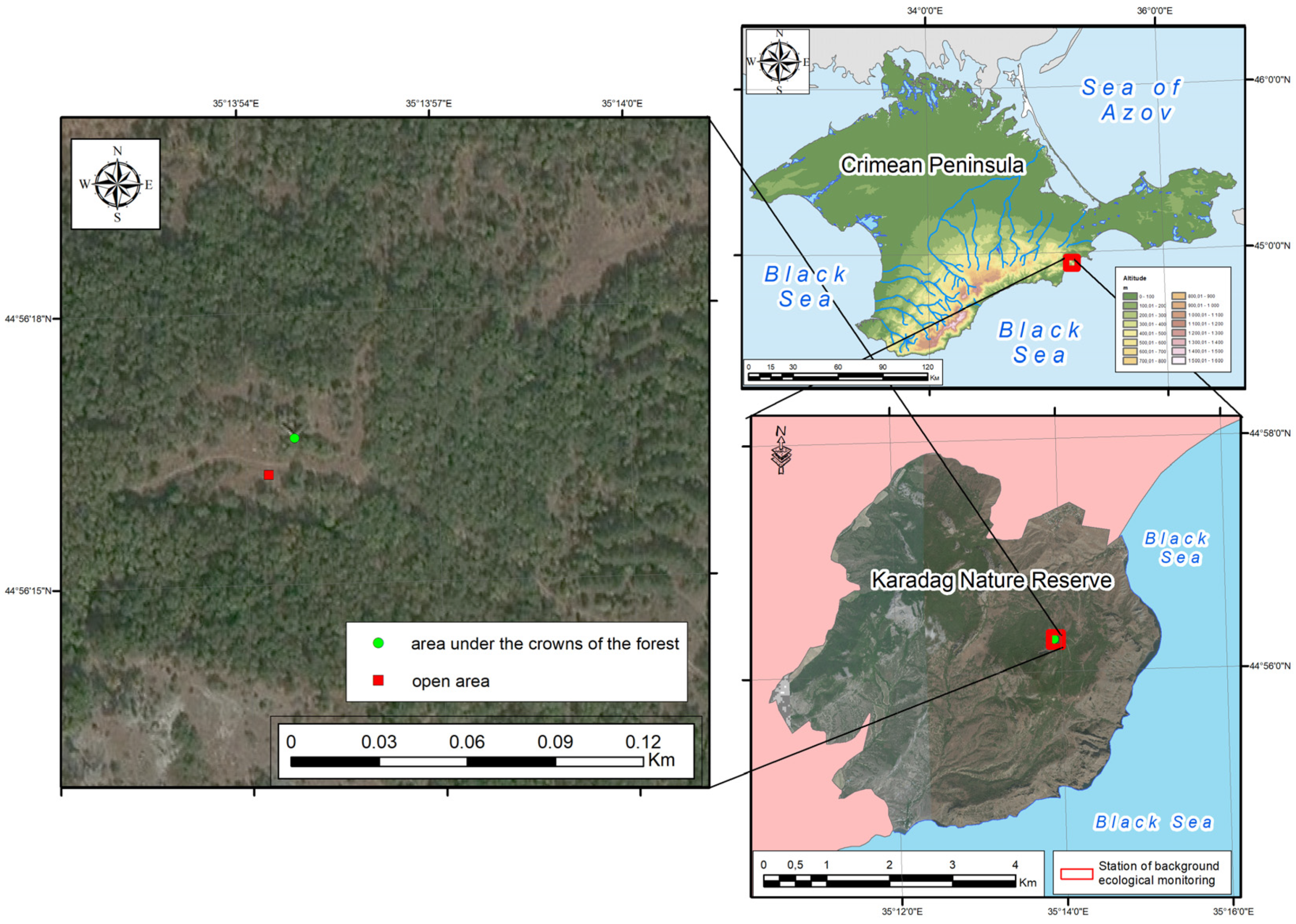
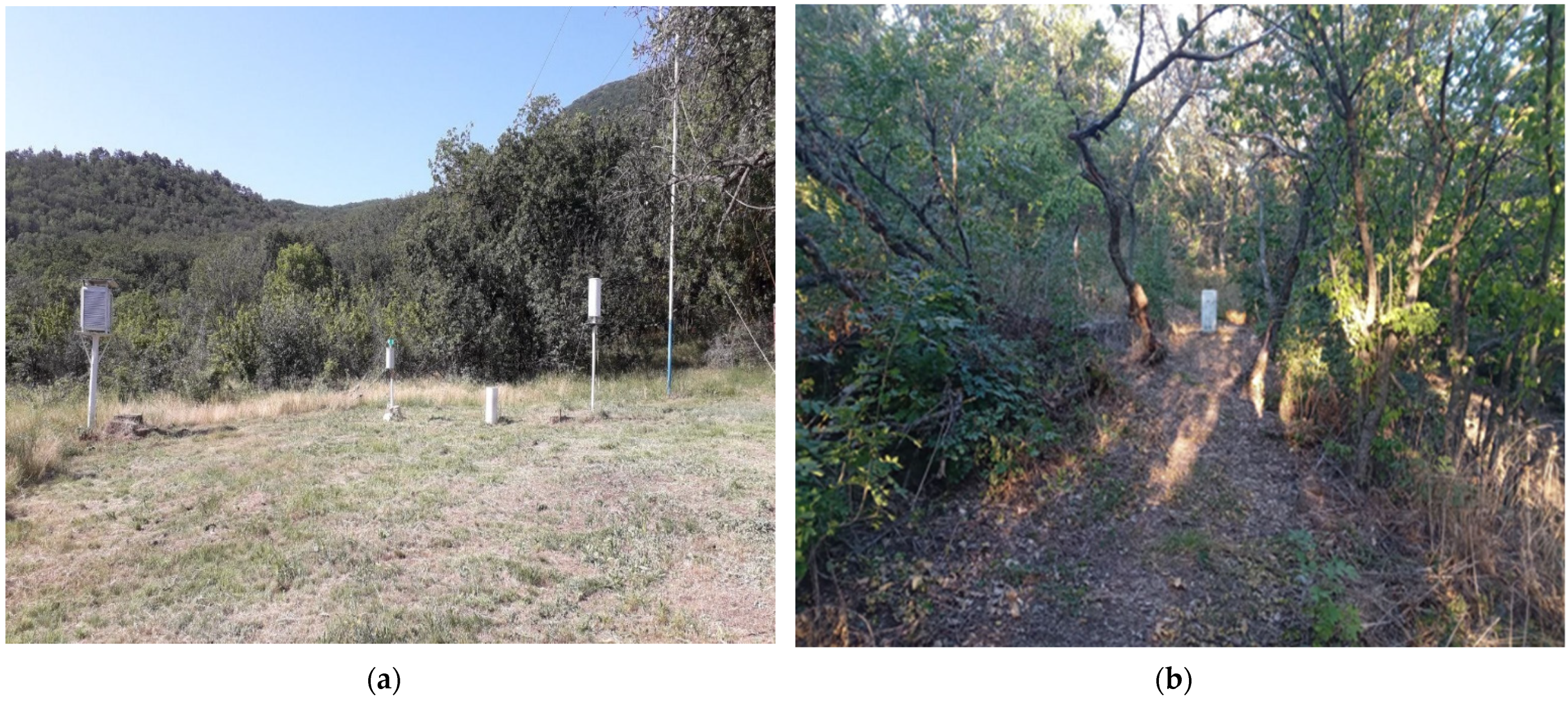
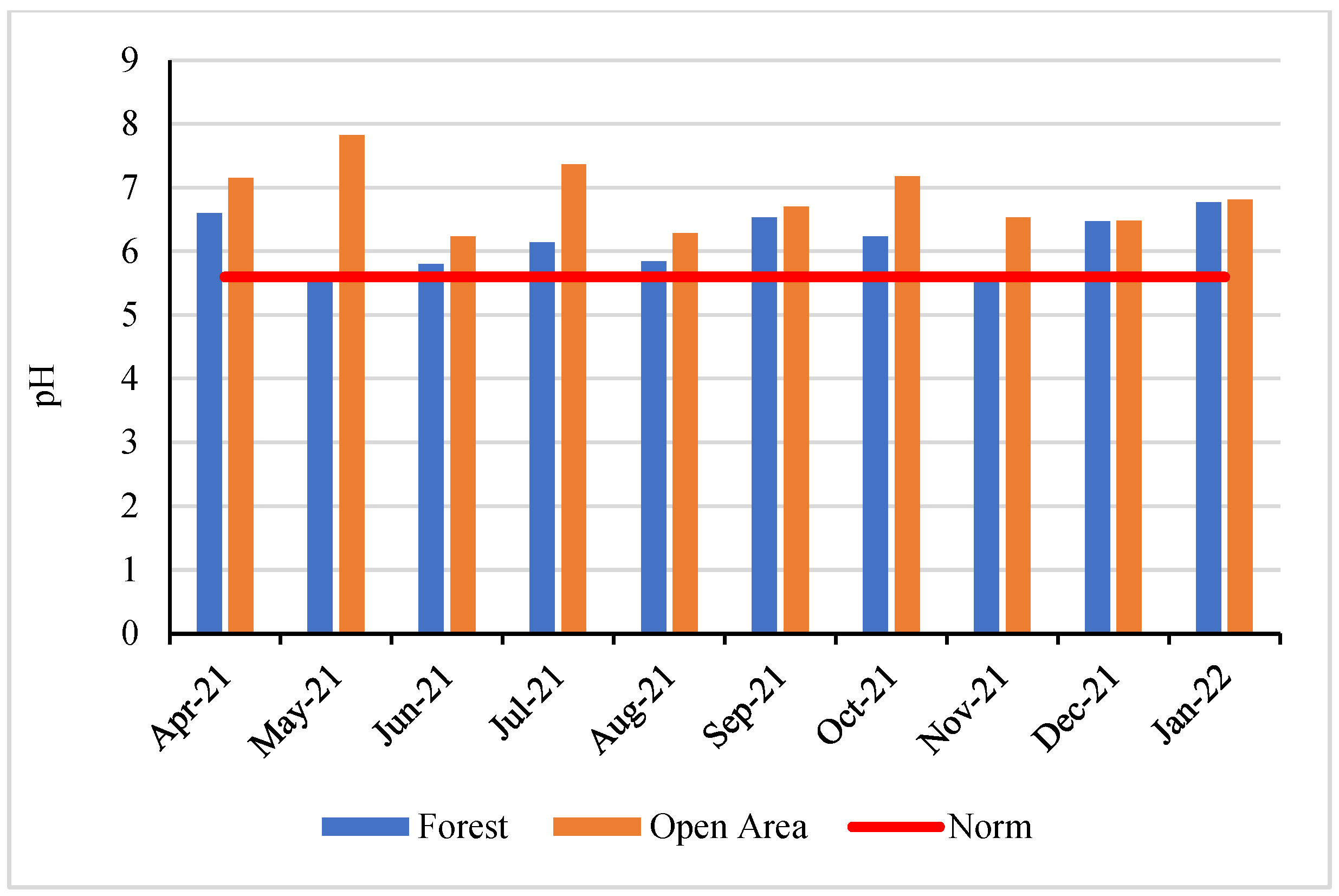
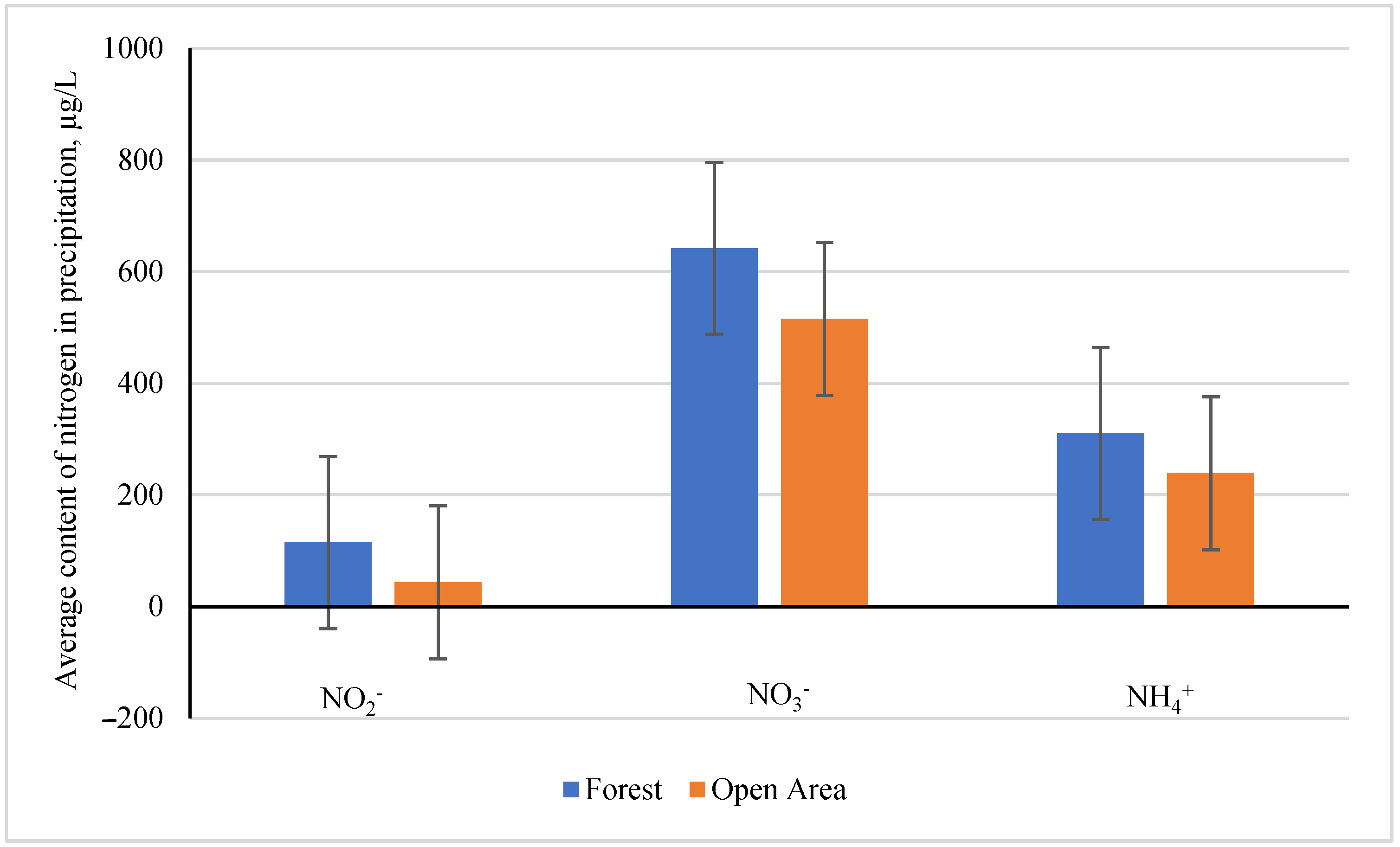
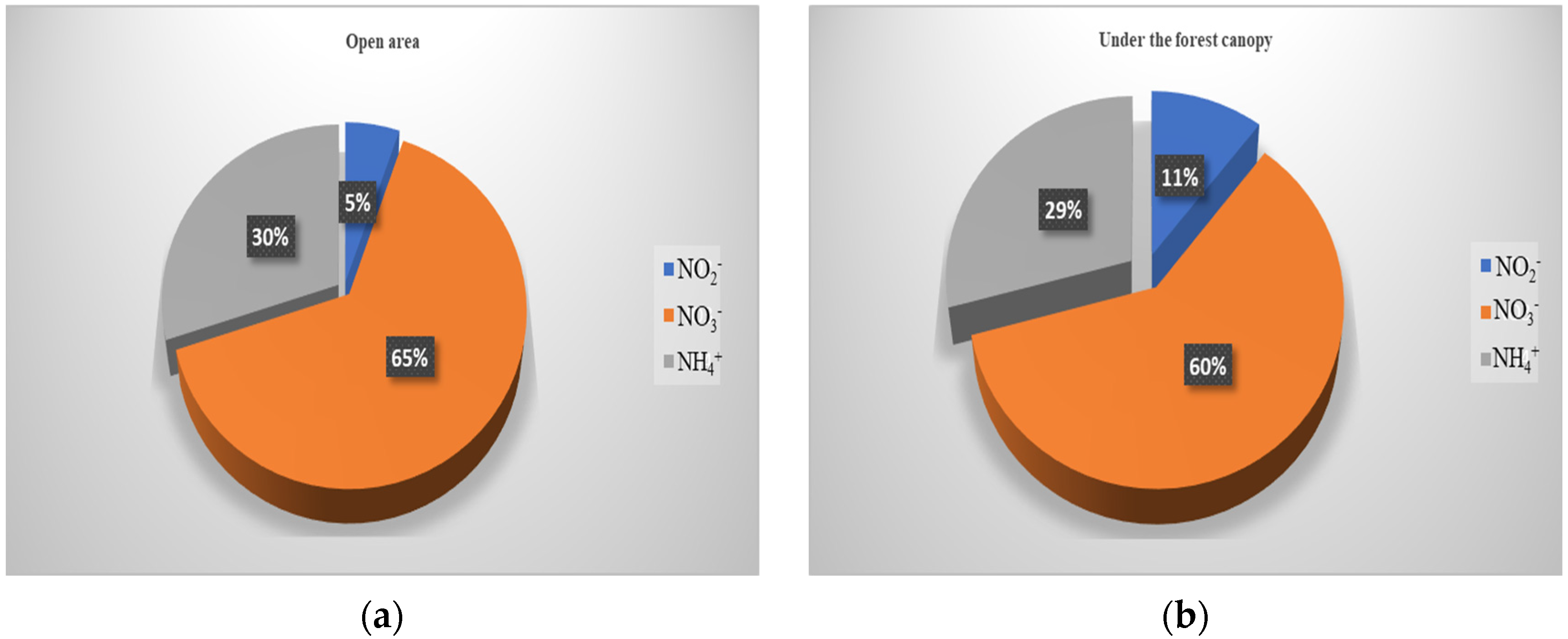
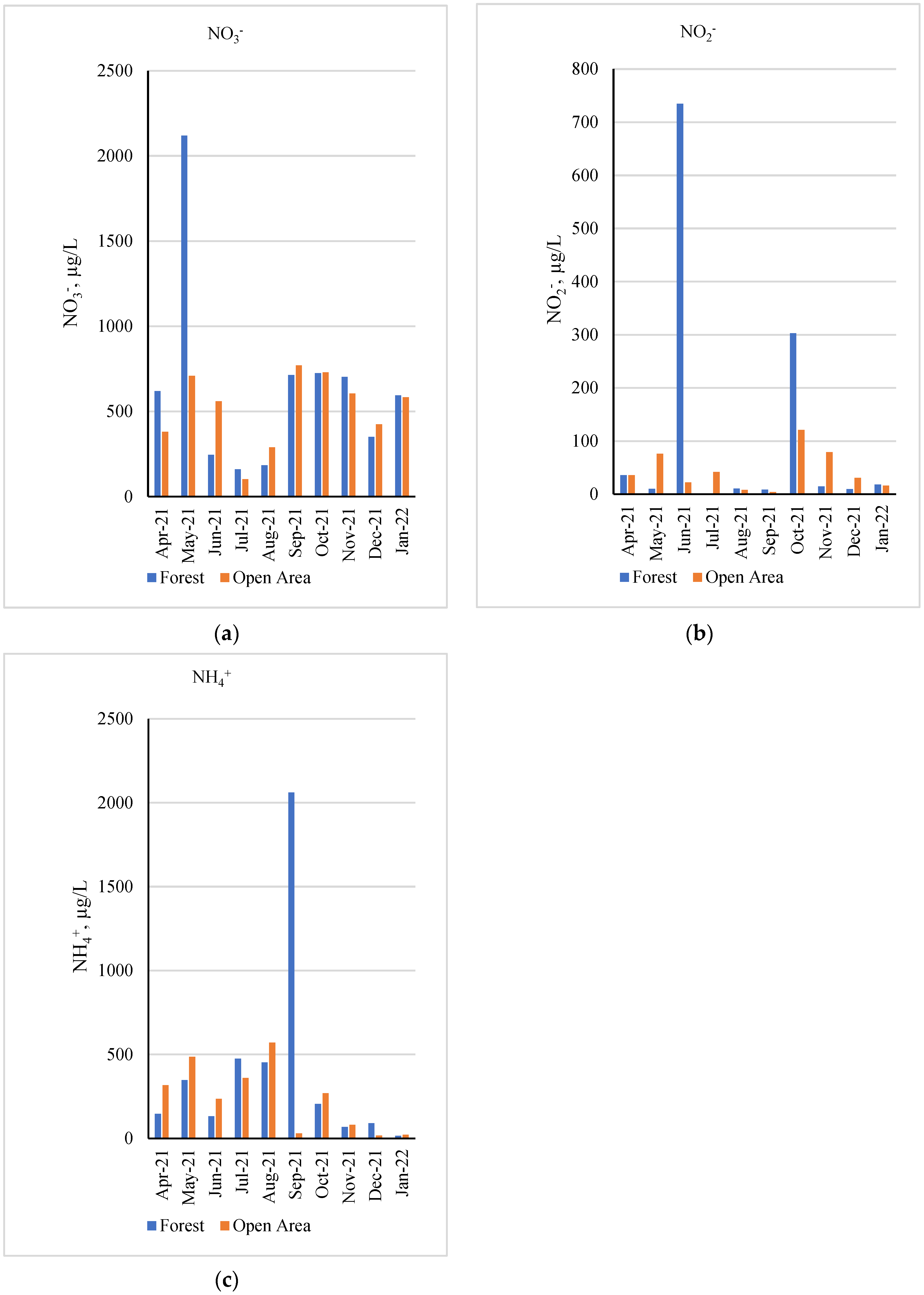
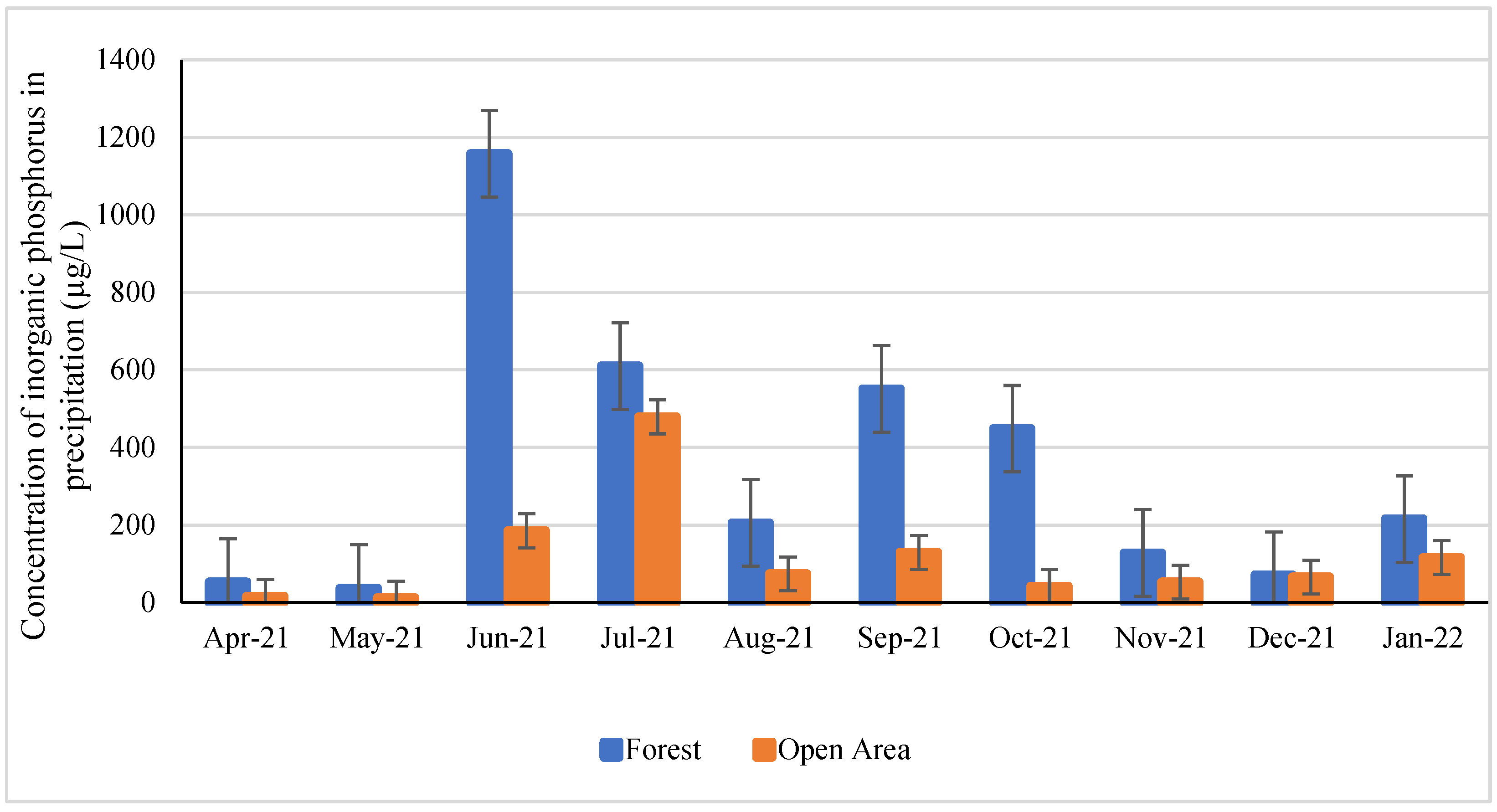
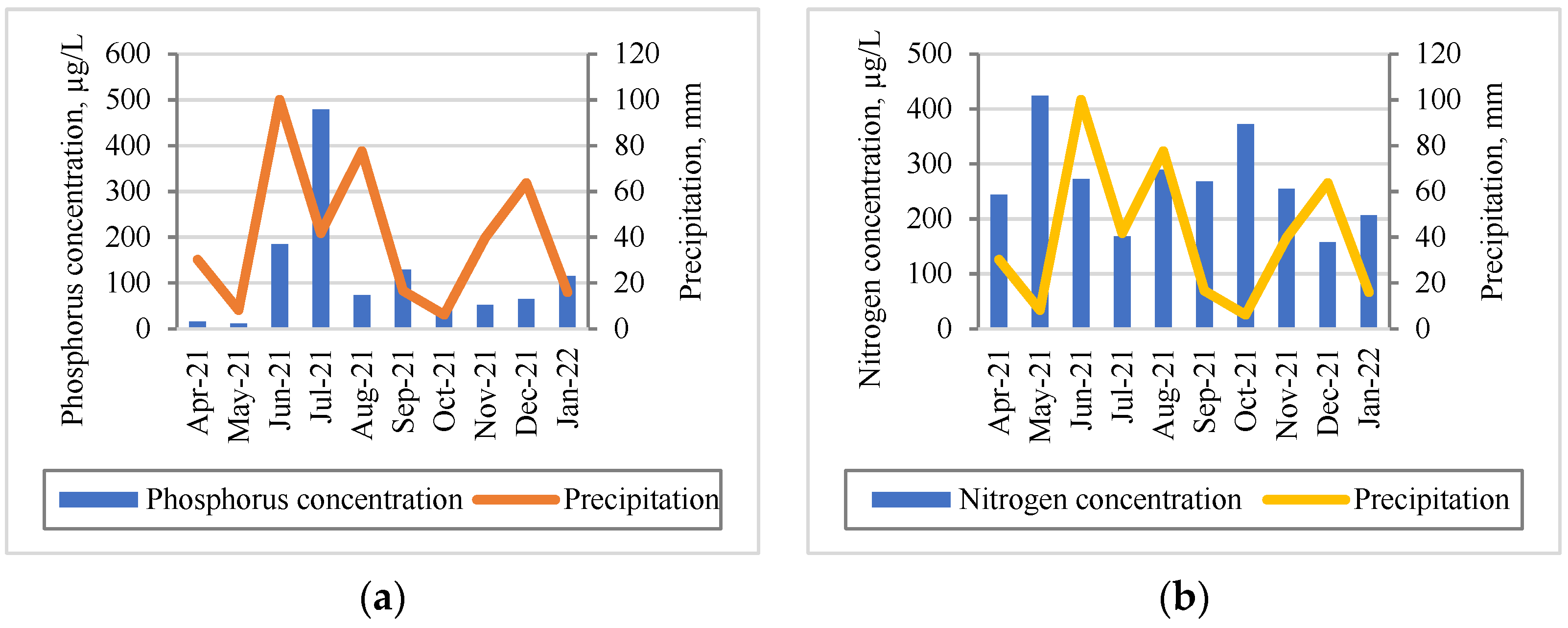
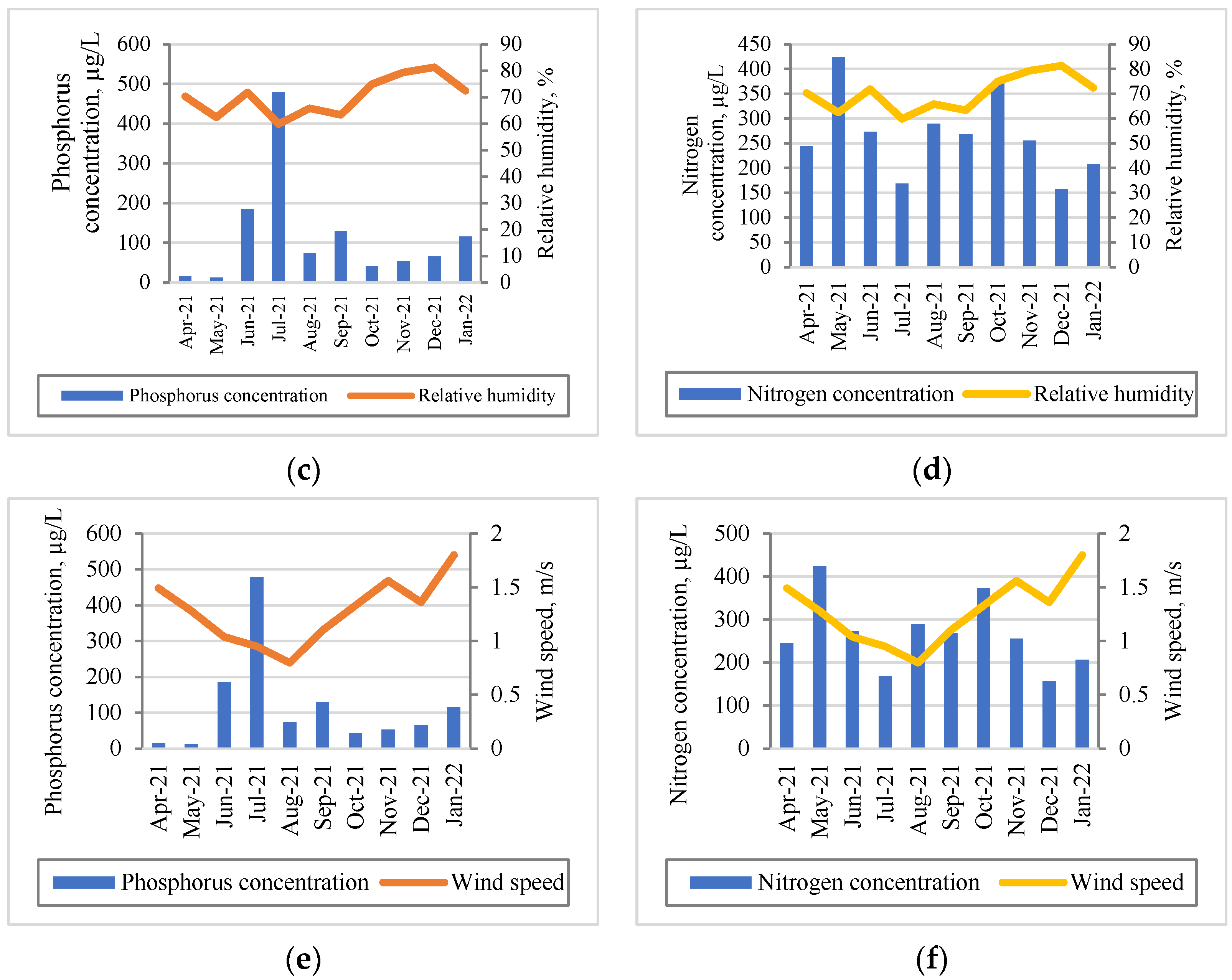

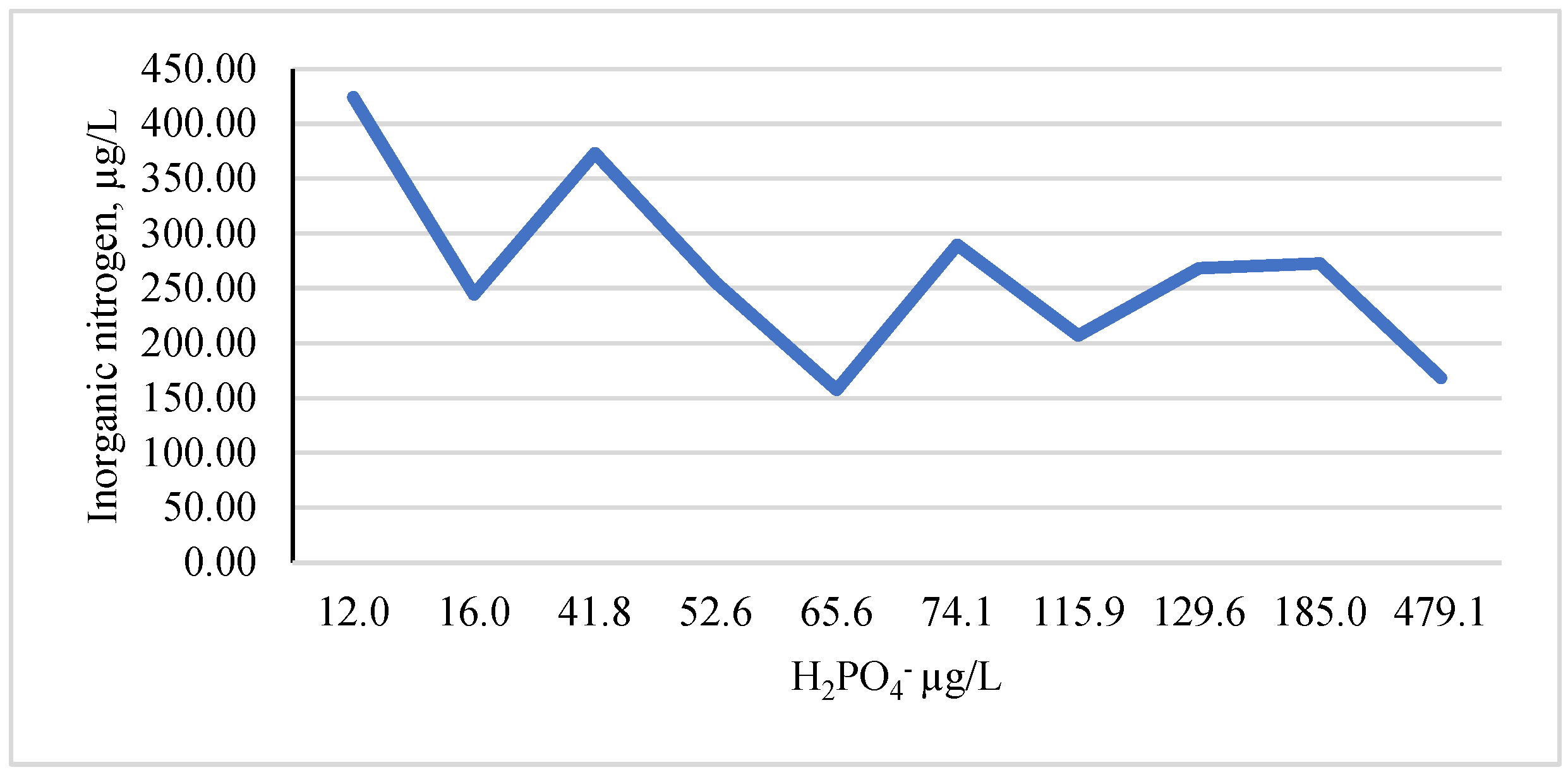
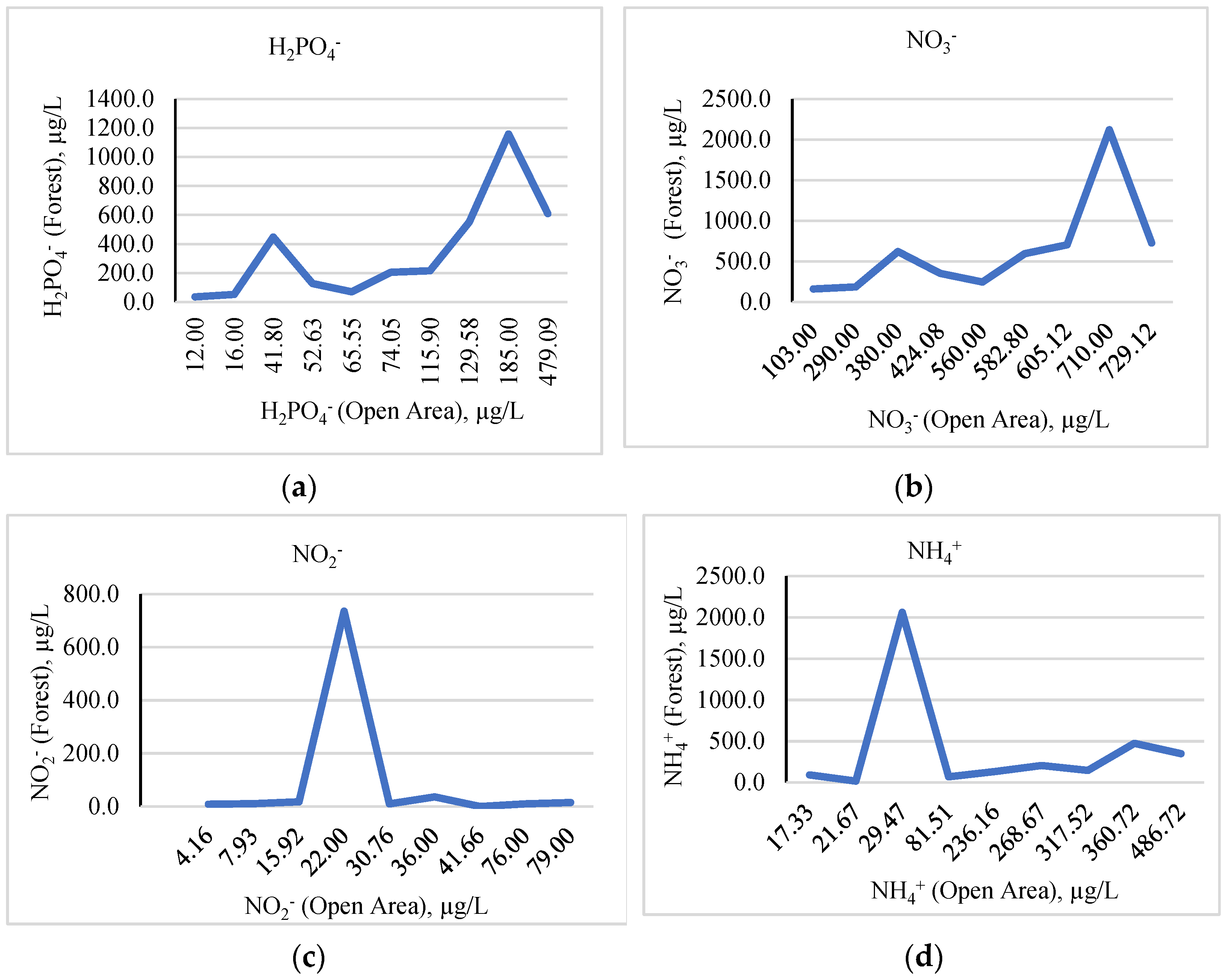
| NO2− | NO3− | NH4+ | pH | |
|---|---|---|---|---|
| NO2− | 1 | |||
| NO3− | −0.22 | 1 | ||
| NH4+ | −0.20 | 0.05 | 1 | |
| pH | −0.24 | −0.33 | 0.19 | 1 |
| NO2− | NO3− | NH4+ | pH | |
|---|---|---|---|---|
| NO2− | 1 | |||
| NO3− | 0.34 | 1 | ||
| NH4+ | 0.14 | −0.37 | 1 | |
| pH | 0.51 | 0.07 | 0.34 | 1 |
| H2PO4− | N | Amount of Precipitation | Relative Humidity | Wind Speed | |
|---|---|---|---|---|---|
| H2PO4− | 1 | ||||
| N | −0.48 | 1 | |||
| Amount of precipitation | 0.22 | −0.34 | 1 | ||
| Relative humidity | −0.47 | −0.22 | 0.18 | 1 | |
| Wind speed | −0.44 | −0.09 | −0.50 | 0.57 | 1 |
| Open Area | |||||
|---|---|---|---|---|---|
| H2PO4− | NO2− | NO3− | NH4+ | ||
| Forest | H2PO4− | 0.56 | −0.18 | 0.01 | −0.06 |
| NO2− | 0.06 | 0.09 | 0.21 | 0.01 | |
| NO3− | −0.52 | 0.44 | 0.59 | 0.20 | |
| NH4+ | 0.15 | −0.36 | 0.28 | −0.14 1 | |
Disclaimer/Publisher’s Note: The statements, opinions and data contained in all publications are solely those of the individual author(s) and contributor(s) and not of MDPI and/or the editor(s). MDPI and/or the editor(s) disclaim responsibility for any injury to people or property resulting from any ideas, methods, instructions or products referred to in the content. |
© 2023 by the authors. Licensee MDPI, Basel, Switzerland. This article is an open access article distributed under the terms and conditions of the Creative Commons Attribution (CC BY) license (https://creativecommons.org/licenses/by/4.0/).
Share and Cite
Pham, C.N.; Gorbunov, R.; Lapchenko, V.; Gorbunova, T.; Tabunshchik, V. Biogenic Elements of Atmospheric Fallout and Impact of Sub-Mediterranean Forest Communities of Downy Oaks on Changes in the Chemical Composition of Atmospheric Precipitation. Forests 2023, 14, 294. https://doi.org/10.3390/f14020294
Pham CN, Gorbunov R, Lapchenko V, Gorbunova T, Tabunshchik V. Biogenic Elements of Atmospheric Fallout and Impact of Sub-Mediterranean Forest Communities of Downy Oaks on Changes in the Chemical Composition of Atmospheric Precipitation. Forests. 2023; 14(2):294. https://doi.org/10.3390/f14020294
Chicago/Turabian StylePham, Cam Nhung, Roman Gorbunov, Vladimir Lapchenko, Tatiana Gorbunova, and Vladimir Tabunshchik. 2023. "Biogenic Elements of Atmospheric Fallout and Impact of Sub-Mediterranean Forest Communities of Downy Oaks on Changes in the Chemical Composition of Atmospheric Precipitation" Forests 14, no. 2: 294. https://doi.org/10.3390/f14020294








